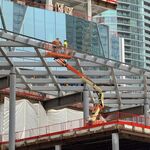nfitz
Superstar
That's a very good point.That central and south section will be very frequent. It includes the majority of the stations (14 of 26) and 28 km of the 67 km project.2/3 of the REM, from Brossard to Bois-Franc in St-Laurent, will have service every 2min30sec at peak time, every 5 minutes the rest of the day. That's a métro service.
Service on the 3 northen branches is RER-likish though
West of Bois Franc - suddenly the station spacing gets much wider. There's 7 stations in the 8 km from Bois Franc to the mountain (Blue line at metro Edouard-Montpetit). West of Bois-Franc it branches into 3 much more suburban services, with the next station ranging from about 6.5 km (Sunnbrooke) to 9 km (Sources) depending on the branch.
So 28 km of the 67 km is very metro-like service. The remaining 39 km add only 12 more stations, and the service is more more like RER.
I hadn't realized that all the trains would run through to Brossard - that seems like a lot of capacity and frequency south of Central station for only 5 stations (over 16 km). Heck the 4 stations from Peel Basin to Rive-Sud (that needs a better name!) is almost 15 km. I'd think that half of that capacity would suffice.
So half-RER and half-metro .... a strange beast!





